Black History Month brings to mind certain figures, such as Martin Luther King Jr, Malcolm X, and Rosa Parks. While the importance of these people cannot be overstated, it is also important to highlight some lesser-known voices of the Black community. This month’s lobby display contains Canadian voices, American voices, trailblazing scholarship, and young adult novels focusing on the Black experience.
Viola Desmond Won’t be Budged by Jody Nyasha Warner and illustrated by Richard Rudnicki
In 2016, 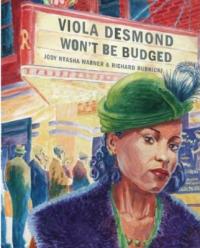 the Bank of Canada announced that Viola Desmond of Halifax, Nova Scotia would be the first Canadian woman to be featured on any note. The vertical $10 bill bearing Desmond’s face was released on Nov 19, 2018. This book recounts the Desmond’s story seeing a movie. She buys a ticket, and sits down, but an usher tells her that “you people” must sit in the balcony section because in 1946, the theatre was segregated. Viola refused to move from her seat, which led to her being put in jail for the night, and to Viola being ordered to pay a fine of $20 (about $275 in today’s dollars!). Viola’s story made her community angry, so they tried to appeal her charge, but the Nova Scotia Supreme Court would not listen and canceled the appeal. Despite this blatant racism, Viola’s actions inspired people to fight segregation, and by the end of the 1950s, it was illegal. Teachers will find that the final page in this book is an excellent non-fiction resource that details the history of Black people in Canada and provides further information on Viola’s life. This story is a valuable and engaging tool for teachers discussing racism and civil rights in Canada in their classrooms.
the Bank of Canada announced that Viola Desmond of Halifax, Nova Scotia would be the first Canadian woman to be featured on any note. The vertical $10 bill bearing Desmond’s face was released on Nov 19, 2018. This book recounts the Desmond’s story seeing a movie. She buys a ticket, and sits down, but an usher tells her that “you people” must sit in the balcony section because in 1946, the theatre was segregated. Viola refused to move from her seat, which led to her being put in jail for the night, and to Viola being ordered to pay a fine of $20 (about $275 in today’s dollars!). Viola’s story made her community angry, so they tried to appeal her charge, but the Nova Scotia Supreme Court would not listen and canceled the appeal. Despite this blatant racism, Viola’s actions inspired people to fight segregation, and by the end of the 1950s, it was illegal. Teachers will find that the final page in this book is an excellent non-fiction resource that details the history of Black people in Canada and provides further information on Viola’s life. This story is a valuable and engaging tool for teachers discussing racism and civil rights in Canada in their classrooms.
Strange Fruit: Uncelebrated Narratives from Black History written and illustrated by Joel Christian Gill
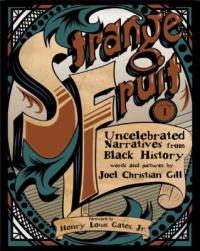 You won’t find stories about Martin Luther King Jr., Angela Davis, or Beyoncé here: Strange Fruit is not about famous Black people, but rather about lesser-known Black people who were “successful in the face of great adversity.” The author has written and illustrated the stories of 9 exceptional African Americans who have gone unsung. Some examples of people and events featured are: Henry “Box” Brown, who spent 27 hours in a box to gain his freedom, and then went on to advocate for abolition; Richard Potter, the first American stage magician and illusionist who hid that he was black; and the forced eviction of black and biracial inhabitants from Maine’s Malga Island in the early twentieth century. Gill writes these stories with a combination of humour and reverence, and this combination is also reflected in his illustrations. This graphic novel would be useful for the teaching of more obscure African-American narratives using a less traditional format.
You won’t find stories about Martin Luther King Jr., Angela Davis, or Beyoncé here: Strange Fruit is not about famous Black people, but rather about lesser-known Black people who were “successful in the face of great adversity.” The author has written and illustrated the stories of 9 exceptional African Americans who have gone unsung. Some examples of people and events featured are: Henry “Box” Brown, who spent 27 hours in a box to gain his freedom, and then went on to advocate for abolition; Richard Potter, the first American stage magician and illusionist who hid that he was black; and the forced eviction of black and biracial inhabitants from Maine’s Malga Island in the early twentieth century. Gill writes these stories with a combination of humour and reverence, and this combination is also reflected in his illustrations. This graphic novel would be useful for the teaching of more obscure African-American narratives using a less traditional format.
Teaching for Black Lives edited by Dyan Watson, Jesse Hagopian, and Wayne Au
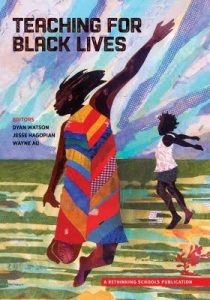 This somewhat unconventional collection of essays examines how schools have a history of neglecting the educational needs of Black students, whether through the sanitization of the history of slavery or through the use of police officers in the classroom, to name a few examples. The editors clearly state in the introduction that this book is a response to the movement for Black lives, and this is evident in the five main topics addressed throughout the book: 1) Making Black Lives Matter in Our Schools; 2) Enslavement, Civil Rights and Black Liberation; 3) Gentrification, Displacement and Anti-Blackness; 4) Discipline, the Schools-to-Prison Pipeline and Mass Incarceration; and 5) Teaching Blackness, Loving Blackness and Exploring Identity. This highly praised collection is a must read for educators who care about the future of Black youth.
This somewhat unconventional collection of essays examines how schools have a history of neglecting the educational needs of Black students, whether through the sanitization of the history of slavery or through the use of police officers in the classroom, to name a few examples. The editors clearly state in the introduction that this book is a response to the movement for Black lives, and this is evident in the five main topics addressed throughout the book: 1) Making Black Lives Matter in Our Schools; 2) Enslavement, Civil Rights and Black Liberation; 3) Gentrification, Displacement and Anti-Blackness; 4) Discipline, the Schools-to-Prison Pipeline and Mass Incarceration; and 5) Teaching Blackness, Loving Blackness and Exploring Identity. This highly praised collection is a must read for educators who care about the future of Black youth.
African-American/Afro-Canadian Schooling: From the Colonial Period to the Present by Charles L. Glenn
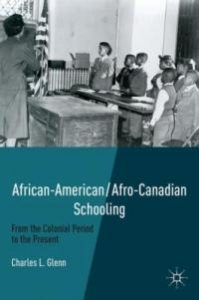 This book is an examination of the history of Black schooling. The desegregation of schools is still quite recent: Brown v. Board of Education was decided in 1954, and the last segregated school in Canada, located in Nova Scotia, was closed in 1983. Black children in both Canada and the United States have been excluded from the “common” public school for decades, and despite integration, Black children still learn a Eurocentric curriculum. Throughout this book, Glenn focuses on the formal schooling of Black children in the United States and Canada as a policy issue, and not the immense struggles of parents and community leaders to provide a decent education for their children. The book discusses topics such as assumptions about race, Jim Crow in the South and in the North, and what lessons to take away from the study of policy surrounding the schooling of Black children.
This book is an examination of the history of Black schooling. The desegregation of schools is still quite recent: Brown v. Board of Education was decided in 1954, and the last segregated school in Canada, located in Nova Scotia, was closed in 1983. Black children in both Canada and the United States have been excluded from the “common” public school for decades, and despite integration, Black children still learn a Eurocentric curriculum. Throughout this book, Glenn focuses on the formal schooling of Black children in the United States and Canada as a policy issue, and not the immense struggles of parents and community leaders to provide a decent education for their children. The book discusses topics such as assumptions about race, Jim Crow in the South and in the North, and what lessons to take away from the study of policy surrounding the schooling of Black children.
Brown Girl Dreaming by Jacqueline Woodson
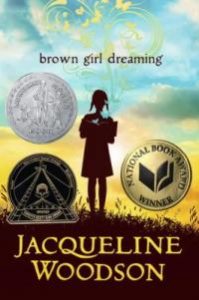 This young adult book is the novelization of Jacqueline Woodson’s childhood. Written in verse, this book tells the story of Jacqueline growing up in two different places: South Carolina and New York, and how she felt between both places. As someone born in the 1960s, she remembers the last vestiges of Jim Crow but also the hope of the Civil Rights movement. The poems that make up this book are succinct and easy to read, but exquisitely written. This book would be excellent for teachers who would like their students to read a firsthand account of growing up Black in the United States in the 1960s and 1970s.
This young adult book is the novelization of Jacqueline Woodson’s childhood. Written in verse, this book tells the story of Jacqueline growing up in two different places: South Carolina and New York, and how she felt between both places. As someone born in the 1960s, she remembers the last vestiges of Jim Crow but also the hope of the Civil Rights movement. The poems that make up this book are succinct and easy to read, but exquisitely written. This book would be excellent for teachers who would like their students to read a firsthand account of growing up Black in the United States in the 1960s and 1970s.
To browse and borrow these books, please visit the OISE Lobby Display on the ground floor of the OISE building.
